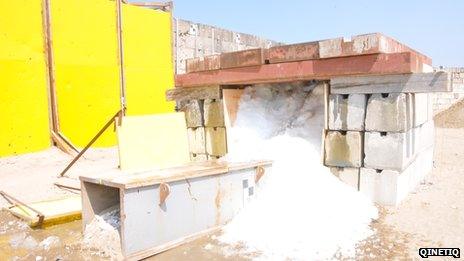British space penetrator passes icy test
- Published
- comments
The penetrator shatters the ice block into a shower of small crystals
UK engineers have tested a projectile technology that they believe could be used to explore the Solar System.
The steel penetrator was fired at a 10-tonne cube of ice to simulate the surface of Jupiter's moon Europa.
It hit the block at a speed of 340m/s and decelerated rapidly, but its structure remained intact, as did its interior components.
Researchers say the penetrator would be a robust and inexpensive way to land instruments on other worlds.
These might be seismometers to study the interior of Mars, or a miniature organic chemistry laboratory to check for microbial activity on icy Jovian satellites.
Scientists envisage several penetrators being deployed at once, carrying perhaps a network of sensors to widely separated locations in the sub-surface.
Being able to get just a few metres down is key, because if life exists anywhere else in the Solar System, it is likely to be buried away from harsh space radiation.
Thursday's test was certainly spectacular.
The full-size, 20kg projectile slammed into the ice block at just under the speed of sound, producing a huge plume of snow.

Europa - Icy moon of Jupiter
Discovered by the famous Italian astronomer Galileo Galilei in 1610
Orbits 670,900km from Jupiter; same hemisphere always faces the gas giant
Nasa's Galileo probe returned pictures of its cracked surface in the 1990s
It likely has a small metal core surrounded by silicate rock
Its global ocean of liquid water is covered by a thick layer of ice
Considered a promising place to look for microbial life beyond Earth

The probe experienced a peak deceleration of 24,000g. To put that in context, an ejecting fighter pilot might experience 12-14g.
Its paintwork was scuffed a little after coming to rest against the roof of the concrete holding box, but the projectile was otherwise unaffected by the violent encounter.
"It was really successful because the entry velocity was higher than expected and all the systems we've looked at so far have survived," Marie-Claire Perkinson, the programme's industrial leader from Astrium UK, told BBC News.
The latest demonstration was conducted at Pendine in West Wales. This is where defence company QinetiQ operates a long rocket track, external on which objects can be accelerated to high speed before impacting a target. Normally, this would be a new type of missile that needed to be tested before entering military service.
"It's a classic case of swords to ploughshares," said QinetiQ fellow Phil Church.
Alan Smith, MSSL: "Ice fields are where you'd like to go"
"This is a civilian project where we are applying a lot of our technical capabilities in simulation, experiments and materials, but which we wouldn't be able to do without the Ministry of Defence research over the past 30 to 40 years underpinning it all."
The space penetrator has itself been in development for almost 10 years, and was originally proposed for a British lunar mission called Moonlite, external.
That venture was eventually shelved, but the idea of a "hard lander" was so compelling, the European Space Agency decided to pick up the concept.
Marie-Claire Perkinson: "We need to survive the cold"
It now wants to take the technology through to full maturity.
"Penetrators offer a number of advantages over 'soft landers', which have to slow down to reach the surface safely," explained Esa project manager Sanjay Vijendran.
"They would enable you to get deep into the sub-surface essentially for free, up to three metres without having to drill. And being light means you can deploy a few at once from a single spacecraft orbiter."
Thursday's demonstrator carried accelerometers and data loggers to help engineers better understand the forces of impact.
The penetrator could be ideal for investigating Jupiter's moons
In addition, it incorporated a special spring mechanism to isolate the interior payload compartments from the outer skin of the projectile.
If the penetrator is sent into ice such as exists on Europa or in a shadowed crater on the Moon, it will have to survive not only the collision but also extremely low temperatures, down to minus 200C. Batteries and electronics will quickly stop working in these conditions.

Space penetrator system
Deployed from a carrier satellite from 200km; retro-rocket slows the fall to the surface
Designed for hard landing; breaks through ice and regolith (soil) to a depth of 2-3m
Internal components are designed to survive massive deceleration, about 25,000g
Electronics are covered in resin to prevent breakage; voids are filled with glass beads
Instruments might include a sample retrieval drill, microscope and mass spectrometer
A vacuum gap insulates internal compartments from the cold; around -200C on icy moons
Battery needs to last a few weeks; UHF data relay back through the carrier satellite

But the team has designed a suspension system from a Torlon polymer, external. This material will collapse under a high deceleration but then push back to maintain a 2mm insulation gap around the sensitive payload casing.
The post-impact inspection revealed the springs had done precisely what was expected of them.
The test penetrator also carried a mini-drill that on a real mission could push out into the surrounding ice to grab samples for onboard analysis.
On this occasion, the drill was not operated but the developers, Rapid Space Technologies, should get a lot of feedback on how their equipment coped with the huge loads from the impact.
Ultimate test
Future work will now concentrate on battery and communications capabilities. A penetrator will likely live for only a few weeks once in place, and it will need sufficient power to run its experiments and then radio the results to the spacecraft that deployed it for onward relay to Earth.
Engineers believe they should have a flight-ready system before the end of the decade.
As yet, no mission opportunity for a penetrator has been identified.
Esa has a spacecraft called Juice going to Europa in the next decade, but there is no space onboard for this technology.
Phil Church: "The penetrator leans on MoD heritage"
Nonetheless, the British team is hopeful an attractive opportunity will arise soon.
"We will need to demonstrate it all, end-to-end," Alan Smith, the director of the Mullard Space Science Laboratory, University College London, told BBC News.
"This will involve firing one of these demonstrators into an ice target, get it to sample the ice and transmit the data from the target without human intervention.
"That's the ultimate demonstration - a real penetrator doing its job. We're about three years away from that position."

The 10-tonne block of ice was reduced to a pile of snow after the impact
- Published20 March 2013

- Published2 May 2012
